FRIC
Front to Rear Interlinked Suspension
In F1, if you're not moving forward, you're moving backwards. Every year in Formula One there is a new development that one team brings out and is touted as a game changer, all teams complain about the legality of such a device, but eventually end up copying. Formula One is always ripe with new innovation. In 2008 Ferrari bring nose cone with the hole, 2009 Brawn GP had the double diffuser, in 2010 McLaren had the F-Duct, 2011 saw Red Bull pioneer and perfect exhaust blown diffusers and 2012 coanda exhaust. In 2012 we had Mercedes bring out the Double DRS. One area that has piqued particular curiosity during 2013 is its unique complex interlinked suspension, named 'FRIC' by the media, which has helped Lotus E21 and Mercedes W04 to reach competitivity for this year. The system was first introduced by Mercedes in 2011 and for the past two years, they have been working on it to perfect the mechanism. Lotus catch up soon after and now other teams are trying similar solutions. Very recently during China GP 2013, the Marrusia F1 Team also introduced this system.
When a car drive on the track it goes through a number of movements. It pitches under braking, it rolls on turn-in to the corner and on corner exit. There are a lot of changes in terms of stability and ride height and a significant amount of downforce is lost as a result. If you could make the car more stable through those changing dynamics and fix the ride height through those manoeuvres, you would make life a lot more easy. So a lot of innovations like this one are designed to produce a stable ride height through a manoeuvre, optimise aerodynamics and maintain downforce.
The FRIC or “Front and Rear Inter-Connected” suspension is a system which links the front and rear suspension of the car using hydraulics and aims to give better stability and drivability for the driver, so called stabile an consistent aerodynamic platform.
There are various theories as to how Lotus and Mercedes system look like and how it work, because unlike an F Duct wing or a Coanda exhaust, the FRIC system is hard to see as it is completely internal. The basic principle behind FRIC suspension is to essentially keep the all four corners of the car at a constant ride height under braking, acceleration and during cornering. The only difference between today’s FRIC system and Williams FW14 and FW14B in the early 1990’s electronically controlled active suspension is that the FRIC system is totally passive and it is not controlled by any electronics. Mercedes idea is inertia based, and doesn't use electrics or mechanical input from the driver to work. Which makes it perfectly legal and falls within the FIA technical regulations?
Teams have been using interlinked suspension for a number of years now in order to control either Roll or Heave or in the case of Mercedes both in same times, which allows them to control Pitch. Ferrari were one of several teams to run a cable-based system in the 1970s.
The advantages of running such systems is helping with mechanical grip and aiding in a consistent and stabile aerodynamic platform. You want a nice softly sprung car, but you cannot do that because you compromise the aerodynamics too much. Aerodynamicists will argue that given a stiff car (rigid aero platform) they can create enough downforce that the suspension becomes irrelevant, with the forces acting on it regulating the driver’s ability to corner as the car is effectively sucked to the ground. But platform must have constant ride high within millimeters. ‘Active Suspension’ created this bridge back in the 80′s, early 90′s with the driver given a more consistent platform as the computers fought the car’s needs to pitch or roll. The interlinked suspensions of today are doing a similar thing but passively through the use of hydraulics. So, system can help to generate more underbody downforce as it gives a degree of control over how the car changes attitude at speed when downforce is increasing. It also allows some degree of ride height/rake control when the car is braking.
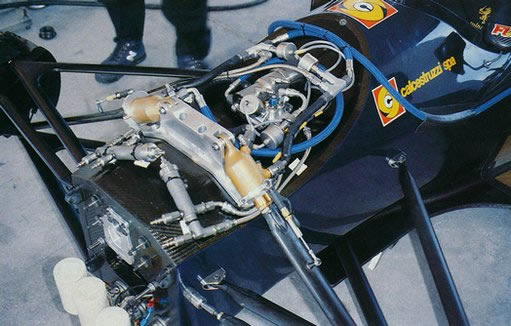 |
The Minardi FRIC system introduced on Minardi M193 |
Nothing is new in F1. Twenty years ago (1993) when active suspension rapidly gained popularity, Gabriele Tredozi (Former Minardi and Scuderia Toro Rosso engineer) and Aldo Costa (Former Minardi, Ferrari and today Mercedes AMG engineer), Minardi Formula 1 team created they own passive suspension system they used on Luigi Martini’s and Fittipaldi’s M193. It was equipped with a passive hydraulic system. There was an external pump which pressurized the system, but the car was also equipped with traditional suspension. It worked on the dampers controlled by hydraulic lines with the strut that sent the circuit under pressure. Then they made the system fully active adding electronic control ready to use following year. Unfortunately, the FIA banned the system, so they found their selves with very advanced, but not usable suspension. However, next year they continued to use it without making it active. The goal was to minimize the variations in height between the front and the rear during braking and acceleration. In order to passively manage pitching of the car, they used cross-connected links of the front axle with the rear. In this way, when the vehicle was under braking, the front actuator created a vacuum in the back, occupied by the oil from the rear, so the rear also crushed to the ground. Doing so kept the height difference unchanged. Cross-connection also helped in the corners. When the load was greater on the outside rear wheel, intervened on the inside front wheel limiting body roll.
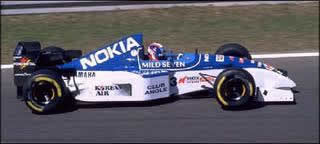 Tyrrell introduced its unique 'Hydrolink' Suspension System, a key feature of Tyrrell Yamaha 023 Grand Prix car. Tyrrell Yamaha 023, the creation of the Tyrrell design team headed by Dr Harvey Postlethwaite, was packed with innovations searching for revival in the team's fortunes after its highly promising 1994 season. The new Hydrolink System was developed with the assistance of Fondmetal Technologies to enhance mechanical grip and give back to Tyrrell cars some of the performance benefits enjoyed by Formula 1 cars fitted with the sophisticated computer-controlled active suspension systems in 1992-93. Chief advantage of the system was the way it allows independent control of the suspension's bump and roll characteristics and enables the car's handling to be adapted to individual tracks with great precision. The system offered substantial theoretical benefits but these were not seen on the track where the cars proved to be very nervous and difficult to drive. The team started the season in great fashion with new signing Mika Salo driving as high up as third place in Brazil, When the teams reached the first European Grand Prix, in San Marino, it became evident however that the new chassis suffered from handling problems. As it turned out the system couldn't make a great car out of an average one. The team returned to using ordinary suspension for the second half of the season.
Tyrrell introduced its unique 'Hydrolink' Suspension System, a key feature of Tyrrell Yamaha 023 Grand Prix car. Tyrrell Yamaha 023, the creation of the Tyrrell design team headed by Dr Harvey Postlethwaite, was packed with innovations searching for revival in the team's fortunes after its highly promising 1994 season. The new Hydrolink System was developed with the assistance of Fondmetal Technologies to enhance mechanical grip and give back to Tyrrell cars some of the performance benefits enjoyed by Formula 1 cars fitted with the sophisticated computer-controlled active suspension systems in 1992-93. Chief advantage of the system was the way it allows independent control of the suspension's bump and roll characteristics and enables the car's handling to be adapted to individual tracks with great precision. The system offered substantial theoretical benefits but these were not seen on the track where the cars proved to be very nervous and difficult to drive. The team started the season in great fashion with new signing Mika Salo driving as high up as third place in Brazil, When the teams reached the first European Grand Prix, in San Marino, it became evident however that the new chassis suffered from handling problems. As it turned out the system couldn't make a great car out of an average one. The team returned to using ordinary suspension for the second half of the season.
So, let’s take a deeper look into the working of the FRIC Suspension.
Well it’s an area that is difficult to explain in it’s entirety with images because the teams hiding it and most of the system being enclosed under bodywork. But in a rare shot of the rear end of the Mercedes W02 we can see how the team is hydraulically linking both sides of the suspension.
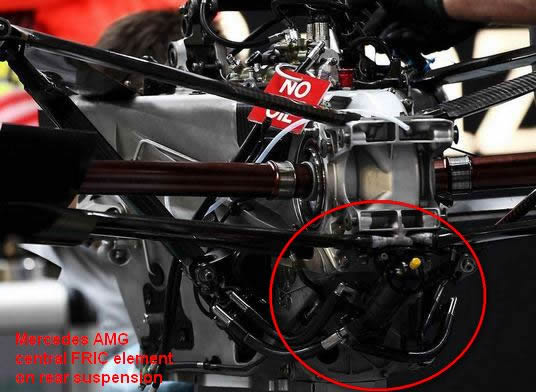
When a car goes through a corner it goes through a number of movements; it pitches under braking, it rolls on turn-in to the corner and on corner exit. There are a lot of changes in terms of stability and ride height and a significant amount of downforce is lost as a result of constantly changing ride height.
With Rake being more and more important to those cars aero set up this generation of F1 cars is very sensitive to roll and pitch, so anything that can minimize the roll angle is definitely a big advantage. If you could make the car more stable through those changing dynamics and fix the ride height through those maneuvers, you would make life a lot easier. This has been the focus of aerodynamic development in F1 since the late 2000s. The challenge for the aerodynamicist is to assess the trade-offs between downforce and smoothing out the ride and much of the work that goes on at F1 tracks in the build up to a race is focused on getting a good compromise for the race weekend. Basically, the engineers are trying to maintain a static ride height as the car pitches and rolls through corners.
The FRIC suspension controls the heave, pitch and roll of the car. Heave is when the car is moving up and down vertically. Heave tends to be caused by the car's aerodynamics compressing the suspension at speed. When this occurs at just one end of the car, it's known as pitch. Pitch is when a car’s nose dives under braking, the weight and balance of the car gets transferred forward. During acceleration the weight and balance of the car shifts towards the rear, the nose of the car lifts up. Roll is when a car corners the weight and balance of the car gets transferred to the opposite direction of the turn. I.e. if you’re turning right, the weight and balance of the car gets transferred to the left and vice versa.
All of these effects will take grip away from the unloaded tires. More crucially, all of these effects move the car's aerodynamic undertray away from their ideal attitude to the track. The front wing, floor and diffuser will be made less efficient when the car pitches and rolls.
On a conventionally suspended car, the parts to control these movements are purely mechanical. Each end of the car may have springs and damper for each wheel, then elements linking each side left-to-right together, such as heave elements with a third spring, an anti-roll-bar, a roll damper and sometimes an Inerter.
'FRIC' system is understood to link the front and rear suspension hydraulically and can be adjusted in a similar way to the brake balance. The ‘FRIC’ device also connects the left and right suspensions, acting like an antiroll bar in order to help keep a constant ride height and aerodynamic balance. The system has been dubbed 'FRIC' by the German press, but it's not clear if this is the team's own term. It's something of a misnomer as the simpler Renault-style systems are front to rear connected only. Rather the Mercedes system links all four corners of the car, controlling roll and pitch, not just individually but combining the effect when the car is in both roll and pitch simultaneously.
Cars conventional individual wheel dampers displace hydraulic fluid as the suspension moves, creating higher pressure in one end of the damper and lower pressure in the other. To act as a damper, valves in the damper piston control the rate in which the fluid moves between the two chambers to create the damping effect.
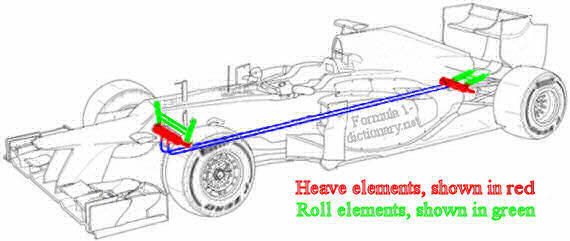
In concept and layout the FRIC system is simple. At each end of the car there are three hydraulic elements: a pair of elements attached to each pull/pushrod rocker control roll and a centre element linked to both rockers' control pitch. The heave elements, shown in red, link front-to-rear to control dive under braking. The roll elements, shown in green, link side-to-side for antiroll. Each of these elements is linked left to right and front to rear. In the FRIC, the fluid is displaced not from one chamber to another, but via pipes through a valve block and into the opposite hydraulic unit. How the upper and lower chambers are interconnected left to right make the system react differently to inputs from the suspension. These being a resistance to roll or heave.
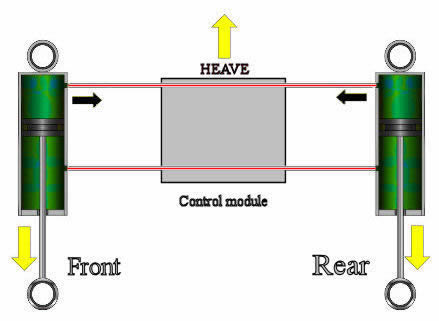
When the car brakes (in heave), weight shifts forwards and the front suspension compresses and the rear rises. The pressure builds up in one side of the centre element on the front suspension, and this pressure in the hydraulic fluid is transferred to the rear centre element.
This increases the spring effect at the front and reduces it at the rear, which means the car will not dive nose down under braking.
When the car is in heave, both upper chambers create high pressure. This creates resistance between the two systems wanting to displace their fluid. This has the effect of increasing the cars heave stiffness. The car's ride height will remain more consistent for better control of the front wing and diffuser aero.
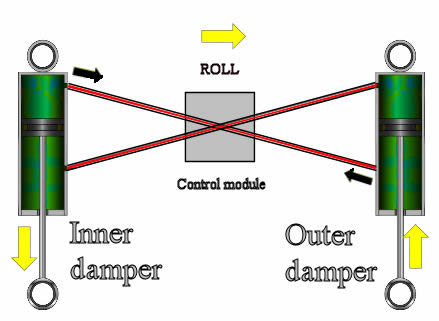
When the car rolls in a corner, the outer hydraulic elements will compress and the inner elements will rise. With the same effect as when the centre element is in pitch, the hydraulic fluid is transferred from one side to the other to increase the spring effect preventing the car rolling. The upper chamber on one side and the lower chamber on the other side create high pressure. As these chambers are cross connected to the high pressure chambers on their opposite side. This creates resistance between the two systems wanting to displace their fluid. This has the effect of increasing in the cars roll stiffness.
Another benefit of the FRIC is that the teams can run the cars very low and with very high downforce levels. Also, as the pitch and roll movements of the car are minimized, the tires have to face lesser load and thus, the system also aids in tire management process. With the FRIC suspension, the cars can be run with a stiffer suspension while not compromising the overall driving comfort for the driver. So, in a way, it indirectly aids the overall aerodynamics of the car and gives a driver more comfort and drivability.
Although outwardly simple the system has far more complexity when the details we looked at. As described it is simple, but as described it want work well, since the suspension would be very stiff at low speeds. For that reason a gas spring is incorporated in the system, and this spring can be locked out in certain speed. This can give a driver a benefit of soft suspension at low speed, while retaining the jacking effect at higher speed.
It’s not a fool proof system by any means though with Mercedes utilizing their system for around 3 years now. The system needs to incorporate flow control valves to provide the spring and damper effect of conventional suspension. Accumulators are needed to account for the change in volume of fluid in the system when the temperature varies.
But perhaps the biggest complexity is when the team starts to link the roll and pitch circuits together. It's possible that the system could be used simply to control pitch and roll separately, but the car is rarely in just one of these modes. Under heavy braking into a slow corner, the car will pitch from the braking and then roll as the steering is turned; this mode is known as warp. In this condition you would want the pitch control to be good, preventing dive. But you would like a little roll to induce some mechanical grip.
If the pipework linking the centre elements could switch a valve to reduce the fluid transfer in the roll hydraulics, you could tune warp stiffness for slow corners. Conversely, the roll control in fast turns when braking is lighter so can be set to a stiffer setting for more aero control, which is critical in high speed corners. With this sort of interconnectivity many different modes could be designed into the system's valving. As long as the valve switching is created by pressure differentials in the system then it is legal. It is of course quite easy to get lost in all of the potential complexity of the system. Hydraulic system takes a while to set up for each track. It certainly appears that Mercedes has spent some painful years setting up its FRIC system and its pace this year is probably as much to do with improved aero as getting the FRIC system tuned in. From what I remember it was along the lines of it took days at the Barcelona test to get the system really right and it just would be difficult at a normal weekend of 3 one hour practice sessions to tune it just right. But with increasing experience during the season things getting better. A lot of experience for next year.
Ross Brawn has been quoted as saying that since Formula One cars were invented and aerodynamics understood, the relation between suspension and aerodynamics has always been a compromise. Essentially, the FRIC allows this compromise to be reduced, allowing for chassis compliance while also ensuring a predictable aero platform.
An FIA technical directive was issued to the teams following the 2014 British Grand Prix warning that cars running FRIC systems could be reported to the stewards, though it stated FRIC would remain on the cars until the end of 2014 if teams agreed unanimously. One can presume that Mercedes has a bigger advantage than others from this system and so the other teams also wish to stop it. FIA's Charlie Whiting concluded that FRIC systems help control the pitch and roll of the car under braking and cornering and maintain its ride height for aerodynamic advantage, and with that controlling the aerodynamic platform of the car. The FIA rules (Article 3.15 of the FIA Technical Regulations) on the matter are deliberately vague, stating that any specific part of the car influencing its aerodynamic performance must remain immobile in relation to the sprung part of the car. They has now concluded, after analysing the current systems, that these has evolved so much that the hydraulic system is now helping to control aerodynamic performance. FRIC enabled the cars to run softer suspension settings and also allowed them to run with lower ride heights, which ultimately meant they produced more downforce.
It is still regrettable that the sport finds a way to change rules mid-way through the season, as it did with the ban on exhaust blowing a few years ago, or Michelin tires wide contact patch tires or Mass dampers. Teams again have to invest a big amount of money to develop a suspension without FRIC.
As most teams had some version of this FRIC suspension, the relative difference in performance between them when it was removed was negligible. These teams are made up of very intelligent people: give them time to scratch their heads and they will find a solution. The real impact was on tire wear.
While not on the scale of the 2014 shake-up, a number of new regulations come into effect for the 2015 season. One we are interested here is new suspension rule. For 2015 Front-and-Rear Interconnected Suspension (FRIC) will therefore be formally outlawed.
The relevant rule change banning the FRIC system is as follows:
10.1 Sprung suspension :
10.1.1 Cars must be fitted with sprung suspension.
10.1.2 Any suspension system fitted to the front wheels must be so arranged that its response results only from changes in load applied to the front wheels.
10.1.3 Any suspension system fitted to the rear wheels must be so arranged that its response results only from changes in load applied to the rear wheels.
Back to the top of the page






